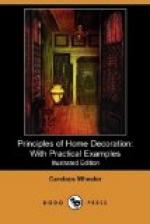CHAPTER III
BUILDERS’ HOUSES
“Mine own hired house.”
A large proportion of homes are made in houses which are not owned, but leased, and this prevents each man or family from indicating personal taste in external aspect. A rich man and house-owner may approximate to a true expression of himself even in the outside of his house if he strongly desires it, but a man of moderate means must adapt himself and his family to the house-builder’s idea of houses—that is to say, to the idea of the man who has made house-building a trade, and whose experiences have created a form into which houses of moderate cost and fairly universal application may be cast.
Although it is as natural to a man to build or acquire a home as to a bird to build a nest, he has not the same unfettered freedom in construction. He cannot always adapt his house either to the physical or mental size of his family, but must accept what is possible with much the same feeling with which a family of robins might accommodate themselves to a wren’s nest, or an oriole to that of a barn-swallow. But the fact remains, that all these accidental homes must, in some way, be brought into harmony with the lives to be lived in them, and the habits and wants of the family; and not only this, they must be made attractive according to the requirements of cultivated society. The effort toward this is instructive, and the pleasure in and enjoyment of the home depends upon the success of the effort. The inmates, as a rule, are quite clear as to what they want to accomplish, but have seldom had sufficient experience to enable them to remedy defects of construction.
There are expedients by which many of the malformations and uglinesses of the ordinary “builder’s house” may be greatly ameliorated, various small surgical operations which will remedy badly planned rooms, and dispositions of furniture which will restore proportion. We can even, by judicious distribution of planes of colour, apparently lower or raise a ceiling, and widen or lengthen a room, and these expedients, which belong partly to the experience of the decorator, are based upon laws which can easily be formulated. Every one can learn something of them by the study of faulty rooms and the enjoyment of satisfactory ones. Indeed, I know no surer or more agreeable way of getting wisdom in the art of decoration than by tracing back sensation to its source, and finding out why certain things are utterly satisfactory, and certain others a positive source of discomfort.
In what are called the “best houses” we can make our deductions quite as well as in the most faulty, and sometimes get a lesson of avoidance and a warning against law-breaking which will be quite as useful as if it were learned in less than the best.




